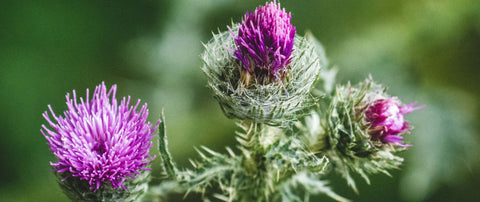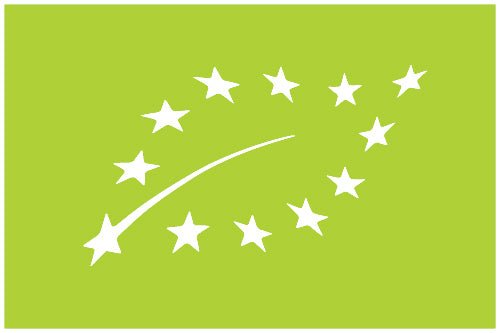Milk thistle is already known to many as a medicinal plant - and rightly so. Even in ancient times, it was used to treat many different ailments. It is still highly valued today and is particularly highly regarded as a superfood and medicinal plant in naturopathy and modern medicine. In this article, you can find out exactly what milk thistle is, what health-promoting properties it has and what the studies behind it look like.
Inhaltsverzeichnis
Where does milk thistle actually come from?
At first glance, the milk thistle (Silybum marianum) is very pretty to look at: the wavy, large green leaves with white marbling and the purple flowers visually distinguish the milk thistle from other types of thistle. The thorns help it to protect itself from attackers and harmful influences.
Botanically speaking, milk thistle belongs to the daisy family and therefore likes sunny and dry conditions. The medicinal plant originated in the Mediterranean region, although it can now be found on all continents. According to tradition, the milk thistle got its Latin name Silybum marianum from the fact that Mary dropped a few drops of her mother's milk on the leaves while she was breastfeeding the baby Jesus. According to legend, these drops of milk formed the marbling on the leaves. The milk thistle is therefore also known as milk thistle. Other common names are lady's thistle, Christ's thistle, holy thistle or Mary's thistle.
What makes milk thistle a superfood?
Why milk thistle is considered a superfood is quite simple: compared to conventional fruit and vegetables, superfoods are known to be particularly rich in nutrients and antioxidants. Due to the high level of media attention, the hype surrounding superfoods has grown rapidly in a very short space of time. In this context, the popularity of milk thistle has also increased after the health and nutrition industry brought it back into the spotlight. Due to its antioxidant properties and positive effects on the liver, milk thistle is therefore considered a valuable superfood and can be consumed in various ways. You can find out more about superfoods and their properties here: Superfoods: Hype or health enrichment?
The most common method of consuming the superfood milk thistle is via dietary supplements in the form of capsules or powder. These preparations contain a controlled dose of silymarin - the active ingredient in milk thistle. This allows the intake to be optimally dosed and integrated into the daily routine. Alternatively, milk thistle can also be consumed as a tea. In this case, however, the dosage is very small. The unmistakable taste of milk thistle in the form of cold-pressed oil is also often used in the home kitchen to enhance salads. The beauty industry has also recognized the benefits of milk thistle: Many creams and oils contain extracts of milk thistle to provide the skin with important nutrients. In particular, the vitamin E it contains is known to promote skin health and significantly support skin care. The skin is supplied with sufficient moisture.

Another exciting way to enjoy the active ingredient in milk thistle is to consume milk thistle seeds and kernels. These can easily be added to bowls or smoothies. If you are considering taking a high-dose form of milk thistle, we recommend that you consult a doctor beforehand to avoid possible side effects.
Active ingredient silymarin
In addition to the leaves and flowers of milk thistle, the seeds in particular are most commonly used in medicine. They contain the majority of the active ingredient silymarin, which is known for the liver-protective properties of milk thistle. The main active ingredients in milk thistle belong to the flavonoid group. Flavonoids are secondary plant substances. Secondary plant substances offer plants in nature protection from external influences and from the animal world. Flavonoids are said to strengthen the immune system and have antioxidant properties. Milk thistle seeds contain the primary flavonoids silybin A and B, silydianin and silychristin. Together, these flavonoids form the falvonoid complex silymarin.
Silymarin is associated with the following positive effects:
- anti-inflammatory
- antioxidant properties
- blood sugar lowering
- liver-supporting and regenerating
- cholesterol-lowering
- digestive
- blood pressure regulating
Properties and study situation
Numerous studies have shown that milk thistle has protective properties against toxic substances. According to the literature, this superfood is hepatoprotective, cardioprotective, neuroprotective, anti-inflammatory and cancer-preventive. The active ingredient silymarin has the ability to fight against biological toxins such as mycotoxins and bacterial toxins as well as chemical toxins such as fluoride, metals and pesticides. 1
In addition to more general studies, there are also numerous specific studies that deal with the effect of milk thistle on certain diseases. We would now like to introduce you to some of these studies:
Milk thistle and liver
The liver is our body's primary metabolic organ. Without it, we would not be able to survive. Among other things, it is responsible for the detoxification of our body, the production of bile, which plays an important role in the digestive process, and for the utilization and storage of nutrients.
The active ingredient silymarin has been used for centuries to treat liver diseases. There is ample preclinical data to suggest that silymarin can counteract oxidative stress and thereby reduce cytotoxicity. This helps to protect intact liver cells or cells that are not irreversibly damaged.
Clinical studies have observed these liver-protective effects in patients with alcoholic or non- alcoholic fatty liver disease and in patients with cirrhosis.
In one study, treatment with silymarin significantly reduced liver-related deaths. It was also found that glycemic parameters could be improved in patients with alcoholic cirrhosis and diabetes with the help of silymarin. The optimal time for the treatment of fatty liver disease and other liver diseases with silymarin should be as early as possible. 2
Milk thistle and the immune system
A study was carried out on quails to show that milk thistle has positive effects on the immune system. Just 0.5% and 1% milk thistle powder added to the diet was enough to improve blood levels, including albumin (a specific protein produced by the liver) and total protein. In addition, the antioxidant capacity of the plasma was improved. Overall, silymarin in the quail diet was observed to increase vitamin D3, calcium and abumin levels, as well as white blood cell counts. 3 These factors enable an improvement of the immune system.
Milk thistle and digestion
Our digestion is an extremely complex and sensitive process. It helps us to utilize food and the nutrients it contains. The tannins and bitter substances in milk thistle seeds can promote and positively influence digestion. Tannins are considered anti-inflammatory and are used in traditional medicine for gastrointestinal inflammation and complaints. The bitter substances it contains stimulate the production of stomach and bile acids. Together they support our digestive function.
Milk thistle and high blood pressure
In this study, the effect of silymarin on high blood pressure was investigated in rats. The rats were administered DOCA salt, a substance that triggers high blood pressure. They were then given silymarin in two different doses (300 mg/kg and 500 mg/kg). During this time, blood pressure and heart rate were measured regularly. It was found that silymarin was able to significantly reduce the heart rate, systolic blood pressure and basal blood pressure of the rats. 4
In summary, it can be said that silymarin has the ability to lower high blood pressure. This makes it easier to control and monitor blood pressure.
Milk thistle and blood sugar
The aim of the following study was to evaluate the effect of silymarin supplementation on metabolism and oxidative stress in patients suffering from type 2 diabetes mellitus using a meta-analysis. The results showed that silymarin can help reduce fasting blood glucose, insulin, LDL cholesterol, hemoglobin A1c and malondialdehyde. The "good" HDL cholesterol, on the other hand, could be increased. 5
Synergy between milk thistle and artichoke
Milk thistle and artichoke are often found in combination in dietary supplements. There is a specific reason for this: this increases the synergy of the active ingredients, which can improve the positive properties on digestion and the liver. Silymarin supports the liver cells and their regeneration, while artichoke promotes the production of bile acid and facilitates the utilization of food. Together, the power plants can develop their full combined strength and can be used in particular for liver diseases or to support detox measures.
Anzeige

Order the ORGANIC MILK THISTLE COMPLEX now!
When should milk thistle preparations not be taken?
As a rule, milk thistle is well tolerated. In rare cases, however, side effects such as gastrointestinal complaints can occur. However, these usually subside once the dosage has been reduced. Pregnant and breastfeeding women and people with liver and bile disorders should not take milk thistle preparations. If you still have questions about this, you can consult your doctor. Taking milk thistle preparations can also interact with liver medication. In addition, milk thistle can increase the effect of medications that are responsible for lowering blood sugar. Therefore, the same applies here: Better safe than sorry!
Conclusion
If you want to actively support your liver, milk thistle - preferably in combination with artichoke - is an ideal option for you. Supplementing with a suitable preparation can make sense, especially for complaints in the digestive tract, to improve liver and bile health and for high blood pressure.
Sources:
-
Fanoudi S, Alavi MS, Karimi G, Hosseinzadeh H. Milk thistle (Silybum Marianum) as an antidote or a protective agent against natural or chemical toxicities: a review. Drug Chem Toxicol. 2020 May;43(3):240-254. doi: 10.1080/01480545.2018.1485687. Epub 2018 Jul 22. PMID: 30033764.
-
Gillessen A, Schmidt HH. Silymarin as Supportive Treatment in Liver Diseases: A Narrative Review. Adv Ther. 2020 Apr;37(4):1279-1301. doi: 10.1007/s12325-020- 01251-y. Epub 2020 Feb 17. PMID: 32065376; PMCID: PMC7140758.
-
Khazaei R, Seidavi A, Bouyeh M. A review on the mechanisms of the effect of silymarin in milk thistle (Silybum marianum) on some laboratory animals. Vet Med Sci. 2022 Jan;8(1):289-301. doi: 10.1002/vms3.641. Epub 2021 Oct 2. PMID: 34599793; PMCID: PMC8788984.
-
Jadhav, G.B., Upasani, C.D. Antihypertensive effect of silymarin on DOCA salt induced hypertension in unilateral nephrectomized rats. Orient Pharm Exp Med 11, 101-106 (2011). https://doi.org/10.1007/s13596-011-0018-2
- Hadi A, Pourmasoumi M, Mohammadi H, Symonds M, Miraghajani M. The effects of silymarin supplementation on metabolic status and oxidative stress in patients with type 2 diabetes mellitus: A systematic review and meta-analysis of clinical trials. Complement Ther Med. 2018 Dec;41:311-319. doi: 10.1016/j.ctim.2018.08.010. Epub 2018 Sep 3. PMID: 30477860.




 DE-ÖKO-006
DE-ÖKO-006
